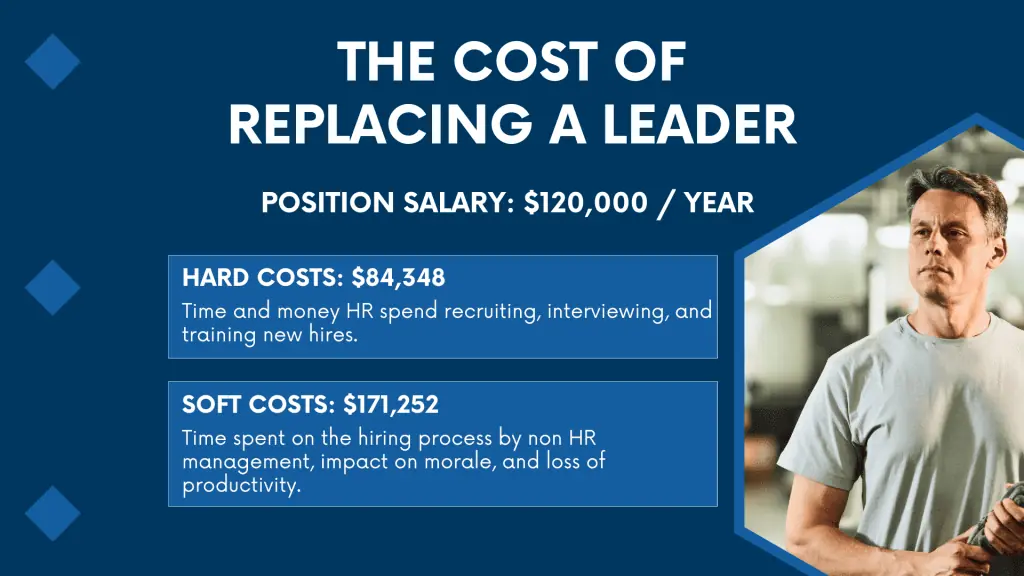The environmental services industry is vital in protecting our health and planet. From ensuring clean water and safe waste disposal to conducting ecological assessments and remediating contaminated sites, environmental services companies are on the front lines of sustainability. However, leadership is just as critical as the services themselves. Influential leaders guide teams, set strategic direction, and drive growth.
Unfortunately, the environmental services industry also faces a significant challenge with leadership retention. Studies estimate that a single leadership vacancy can cost an organization anywhere from 1.5 to 2.5 times the leader’s annual salary in lost productivity, recruitment, and onboarding costs. Employee turnover is expensive! Companies can lose 50-200% of an employee’s salary when they leave, with technical roles and senior positions costing even more. This figure can translate to a significant financial burden for an industry where leadership is crucial.

Leadership Transition: What Happens to Revenue When Leadership Leaves
In contrast, retaining influential leaders delivers a substantial return on investment. A 2020 Gallup study revealed that highly engaged teams led by strong managers experience 21% higher profitability, 22% higher productivity, and 17% lower turnover. This demonstrates the significant positive impact that effective leadership can have on a company’s success.
Therefore, understanding the factors influencing leadership retention and implementing effective strategies to keep your valued leaders engaged and on board is crucial for sustainability and success within the environmental services industry.
Losing a leader can trigger a domino effect of financial burdens for the organization. Firstly, leadership transitions disrupt strategic direction and momentum, potentially leading to missed opportunities and stalled progress. Executives and leadership positions are in transition 25% of the time. Having a structured plan can impact profitability and productivity. Secondly, crucial institutional knowledge walks out the door, requiring significant resources and time to train replacements. This knowledge gap can lead to operational inefficiencies and hinder overall productivity.
Furthermore, high leadership turnover breeds instability and dampens employee morale, potentially leading to increased employee turnover at all levels. Replacing departed team members incurs recruitment and onboarding costs, impacting the bottom line. Additionally, new hires take time to peak performance, meaning productivity dips during the transition period. Combined, these factors translate to lost revenue and profitability in the long run.

Understanding the Landscape: Why Leaders Leave
Leaders in environmental services face unique challenges that can contribute to their decision to leave an organization. Here are some of the key reasons why leaders might choose to move on:
- Lack of career growth opportunities: Leaders who feel stagnant in their roles and see limited pathways for advancement are more likely to seek new challenges elsewhere.
- Work-life imbalance: The demanding nature of the industry, with extended hours, unpredictable schedules, and high-pressure environments, can create significant work-life imbalance, leading to burnout and, ultimately, leadership departures.
- Compensation and benefits: Competitive and comprehensive compensation packages are crucial for attracting and retaining top talent. However, if a company needs to catch up in this area, leaders may be tempted by more lucrative offers from competitors.
- Lack of support and recognition: Leaders need to feel supported and valued within their organizations. A lack of recognition for their achievements and contributions can lead to feelings of isolation and a diminished sense of purpose, leading to a desire to leave.
- Toxic work environment: A hostile work environment characterized by poor communication, lack of trust, and disrespect can significantly impact leader morale and ultimately lead to their departure.

Building a Culture of Retention: Strategies for Keeping Leaders Engaged
By identifying the factors contributing to leadership turnover and implementing proactive measures, environmental services companies can create a more engaging and supportive work environment, fostering long-term commitment from their leaders. Here are some key strategies to consider:
- Invest in leadership development: Providing leaders with opportunities for continuous learning and skill development demonstrates your commitment to their growth and helps them stay relevant and effective in their roles.
- Foster open communication: Establish transparent and open communication channels between leaders and all levels of the organization. This allows leaders to voice concerns, provide feedback, and collaborate effectively with team members.
- Promote work-life balance: Encourage leaders to manage their workload effectively, delegate tasks appropriately, and utilize resources like flexible work arrangements to maintain a healthy work-life balance.
- Offer competitive compensation and benefits: Regularly review and adjust compensation packages to remain competitive. Consider offering tailored benefits packages catering to individual needs and preferences.
- Recognize and celebrate achievements: Publicly acknowledge and appreciate the contributions of your leaders. This can be through verbal praise, performance-based rewards, or opportunities for professional recognition.
- Empower leaders: Give leaders ownership of their roles and the authority to make decisions. This fosters a sense of responsibility, increases engagement, and allows them to utilize their skills and expertise to their full potential.
- Create a positive and inclusive work environment: Foster a culture of trust, respect, and collaboration. Leaders must feel comfortable voicing their opinions, taking risks, and contributing to decision-making.
By implementing these strategies, environmental services companies can demonstrate their commitment to their leaders and create a more attractive and rewarding work environment. This commitment directly translates to increased leadership retention, a factor we’ve established that delivers substantial financial benefits. The rewards include reduced turnover costs, improved operational efficiency, and a more vital, high-performing organization. Investing in your leaders is an investment in your company’s future success – a future marked by financial stability and superior performance.
More From Inflection Poynt
Inflection Poynt is about more than just filling open positions. We leverage data-driven insights to identify high-potential leaders who align with your company culture, fostering long-term commitment to your organization.
For more on retention in the Environmental Services Industry:
Inflection Poynt’s Ultimate Guide to Technician Retention goes beyond technicians, acknowledging the interconnectedness of the entire workforce. While focusing on technician retention, the guide stresses the importance of creating a positive and engaging work environment that benefits everyone. For more information, contact Inflection Poynt or visit our website.



